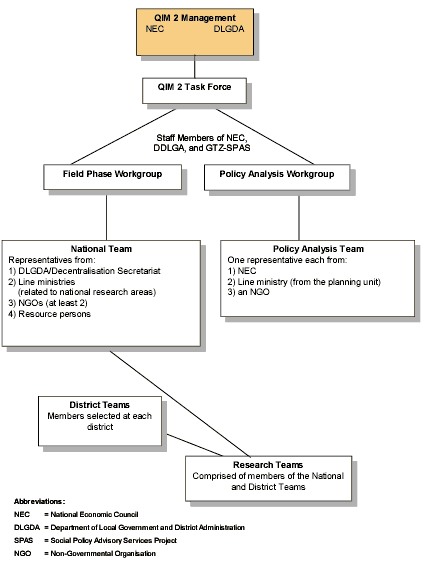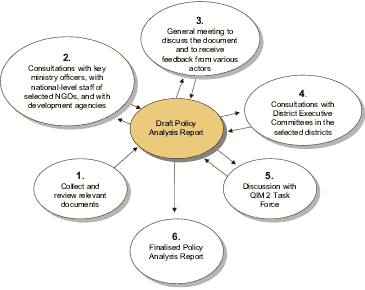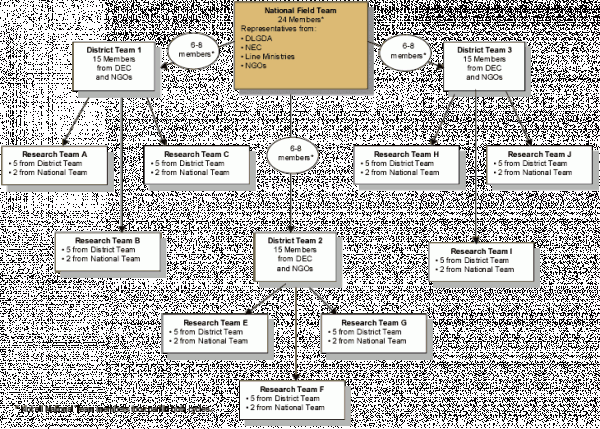 |
Since 1994, poverty alleviation has been the primary aim of the Malawi Government. In order to track and assess changes in the poverty situation, the Poverty Monitoring System (PMS) was created within the National Economic Council (NEC) in 1996. Poverty monitoring has been recognised as essential to maintaining an effective course in poverty reduction. One aspect of this is to observe the impact of policies and programmes on poverty. Qualitative Impact Monitoring of Poverty Alleviation Policies and Programmes (QIM) is the only instrument of the PMS that systematically generates qualitative information on the impact of policies and programmes on poor people’s lives.
QIM is an approach to monitor the impact of policies and programmes on poverty in such a way that impoverished men’s and women’s experiences and views become a vital input into the ongoing fine-tuning of Government policy and action. Main characteristics of QIM are that it:
- is institutionalised – QIM actively involves Government stakeholders and decision-makers in the research process.
- fills existing gaps in information that are uncovered at the policymaking and administrative levels.
- emphasises the feedback, discussion and actual use of the information generated.
- contributes to creating stronger linkages between the three main levels involved in development: national, decentral and community.
- relies on and incorporates information from other monitoring efforts, especially quantitative data.
The QIM exercise is designed to be carried out in a series of cycles so as to maximise learning and to continuously improve the approach. These cycles take place both within a given round of QIM as well as from one round to the next. The first round of QIM in Malawi took place in 1997/98. The process of that round was analysed and used as one key input for the conception of the second round of QIM. QIM 2 was carried out in 2000, incorporating the lessons learned from QIM 1.
The Guiding Objectives of QIM 2
The development of guiding objectives was performed as one of the first tasks after the decision was taken to proceed with a second round of QIM. The overall vision for QIM 2 was formulated as:
In line with the decentralisation policy, QIM is to support policy-makers and decision-takers at the national, decentral and community levels in developing effective poverty-fighting policies, programmes and strategies. It is to accomplish this through providing the information required to help these actors respond to the needs expressed by the poor.
QIM is to be carried out in four phases: the Preparation and Policy Analysis Phase, the Field Phase, the Data Analysis Phase, and the Presentation and Dissemination Phase.
- The Preparation and Policy Analysis Phase: is designed to accomplish four main tasks. The first is to ensure that the QIM investigation is demand-driven by national policy-makers and decentral administrations. The second task is to produce a policy analysis paper upon which the field research is then based, and against which the field phase findings can be compared. Third, to set the parameters for the study (selection of sites, etc.). Finally, the national-level teams who are to carry out the exercise need to be selected and trained.
- The Field Phase: is to be carried out in two cycles of three weeks, each. During the first week of each field phase cycle, members of the national teams train the decentral teams on QIM, the use of PRA tools, and data analysis. The field research in the communities is conducted during the second week. Data is collected and analysed each day. Before leaving the community at the end of the week, the research teams hold a feedback and information-sharing session with the community. Site and decentral-level analyses are performed during the third week.
- The Data Analysis Phase: A decentral report is prepared for each district. The site reports, decentral reports, plus all the raw data and preliminary analyses are assessed at the national level. An interim report is compiled that represents the first product of a workshop. The analysis has to be continued by the Report Writing Team (a small group from the main Task Force) who are expected to complete a final report of the survey findings.
- The Presentation and Dissemination Phase: is an on-going effort to actively carry the findings of QIM into the various dialogues on poverty taking place in the country (including the PRSP process). Presentations have to be made for a variety of stakeholders (e.g., sector ministries, the Parliament, decentral administrations , NGOs, international development organisations, the media, the QIM survey communities, and the public at large).
Preparatory and Policy Analysis Phase

|
 |
Step 1: Development of the QIM conceptual framework, operation plan and budget:
The conceptual framework defines the objectives and guiding principles of the exercise, establishes the structure of phases and steps, and sets the overall research goals. The operation plan specifies what particular tasks need to be accomplished at what time, and spells out who is responsible for their performance. The budget determines the financial resources to be expended on the tasks within each phase.
Step 2: Review of previous research and preliminary identification of sectors:
Recent policy research and literature is reviewed in order to uncover information needs, to ensure that efforts will not be duplicated with QIM, and to identify the broad sectors and policy areas to be investigated by the upcoming round. Setting the general focus of the exercise is necessary to obtain the high-level approval necessary to proceed with the exercise.
Step 3: Selection of districts:
The selection of the districts has ramifications for the research design (sampling). Reasons and criteria for selection must be well-thought out and documented.
Step 4: Presentation of the QIM concept to the Technical Working Committee - TWC:
This step is essential for securing approval to continue with the exercise. The current version of the Concept Document is presented to the TWC so that their comments can be incorporated. Also presented for comments and/or approval are the briefs supporting the policy areas proposed for the round and the preliminary selection of the districts.
Step 5: Initiating involvement of the selected districts:
Once the selected districts have been approved by the TWC they are requested, in a letter drafted by the Task Force, to take part in QIM .
Step 6: Selection of the Policy Analysis Teams:
Policy Analysis Teams are to be selected so as to ensure that the analysis takes up important stakeholder viewpoints.
Lessons-learnt:
Concept development, identification of research areas / districts
- Use of the concept document or the previous process analysis during the workshops is an additional way of saving time since the participants merely need to revise the document rather than having to develop it. Nevertheless, it is necessary that the new objectives have to be set by the participants
- The number of policy areas that need to be investigated should be kept to a minimum. The proposal is that apart from the poverty section (which is a permanent part of QIM), only two national policy sectors should be investigated. The districts could still add an additional policy/programme area - as long as the total volume of impact hypotheses to be checked is kept manageable.
- The selection of districts is very important and it is necessary 1) to become clear on why districts and sites would be selected, and 2) to document the reasons and criteria. Stakeholder involvement in the selection process is important.
Figure 2: The policy analysis process

|
 |
Lessons-learnt:
Involvement of stakeholders, districts and communities
- Once the sectors/policy areas that will be subject of the investigation have been approved, then representatives of the relevant ministries and NGOs should be asked to join the Task Force.
- Smaller policy analysis teams proved a more effective way of conducting extensive consultations on the policy areas with the stakeholders. The approach is recommended as long as: 1) sufficient in-depth consultation with stakeholders is ensured in order to guarantee that their information needs are met, and 2) the workload is not too heavy for the individuals involved. Options for maximising stakeholder involvement in the policy analysis should be pursued.
- In the event that the proposal above is not possible, then more time must be allotted to the policy analysis to allow for greater direct involvement of ministry and NGO officers.
- More transparency is needed on the roles to be played by different members of the National Team, how the selection is made to play the roles, and that they are associated with different amounts of pay. This needs to be done early, and definitely prior to the field phase.
- It is necessary to ensure that the site selection in the districts should be confirmed as soon as possible. This can be undertaken by having the District Leaders visit each community and verify that it meets the criteria. They also should meet with the traditional leaders and explain the QIM exercise to them (including allaying false expectations).
- An effective and implementable strategy is needed to ensure gender balance on the research teams. It may be possible that women local consultants can be enlisted if too few women can be found amongst the ranks of the stakeholders. Another possibility would be to enlist women officers from other districts.
- Also a greater proportion of women must be recruited for the National Team.
- Meetings with the district officials (DEC) are an extremely important step for initiating effective involvement of the districts and for generating their interest in, ownership of, and acceptance of the QIM process.
Sufficient time should be allotted to these workshops so that the site selection and identification of District Team members can be completed during this step.
|
| |
- Step 12: Training the National Team; developing hypotheses and checklist:
This step sets out to accomplish a number of important tasks for the QIM exercise. The tasks include team-building; training in the concepts, methods and approaches required to carry out the QIM field phase; the formulation of the hypotheses to be tested by the research; and the creation of the checklist that guides the data collection. In addition, a Pre-Test is carried out by the National Team.
- Step 13: QIM 2 publicity meeting:
A half-day meeting is held to present and publicise the objectives of the QIM round amongst the secondary stakeholders. These include organisations that are not directly involved in the current round (other ministries, NGOs, donors, civil society groups, the media). The intention is to prepare their acceptance of the findings later on, despite their non-involvement in the current QIM process.
Lessons-learnt:
Coordination, pre-testing
- Sufficient time has to be devoted to pre-tests both for the national and district teams and they should be held at the end of the workshop so that all of the research skills (including qualitative data analysis) can be practised. Extending the workshop to six days is one way of achieving this.
- Involvement of key decision makers, including the DEC, during the finalisation of the data collection sheets has to be assured. It maybe necessary to translate the material into the local languages.
- Informing traditional and local leaders early on is recommended so that organisational arrangements including lodging arrangements for the teams are clarified. More important is the need to discourage false expectations with regard to the whole QIM exercise.
Figure 3: Organigram for the field phase in one field phase cycle

|





